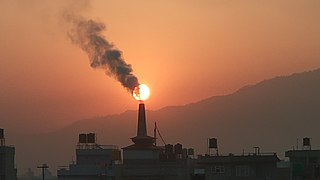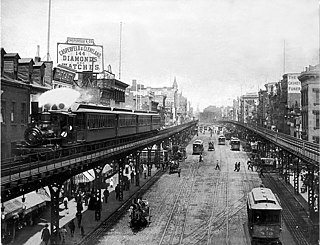
A smokestack industry is a basic, usually cyclical, heavy industry. [1] The factories stereo-typically used in such industries have smoke stacks, hence the name, and produce a high volume of pollution.
Contents
Example industries include:

A smokestack industry is a basic, usually cyclical, heavy industry. [1] The factories stereo-typically used in such industries have smoke stacks, hence the name, and produce a high volume of pollution.
Example industries include:
Smokestacks were first used during Industrial Revolution between the 18th and 19th centuries and were known to foul the airs in most larger cities but were most noted in large industrial centers like Manchester England or Pittsburgh Pennsylvania. During the dramatic growth and evolution of systems used to produce electricity coal burning central electric stations that relied on direct current were found throughout cities that released noxious fumes and soot into the city air. Taller smokestacks helped to reduce this environmental issue.

Pollution is the introduction of contaminants into the natural environment that cause adverse change. Pollution can take the form of any substance or energy. Pollutants, the components of pollution, can be either foreign substances/energies or naturally occurring contaminants.

Smog, or smoke fog, is a type of intense air pollution. The word "smog" was coined in the early 20th century, and is a portmanteau of the words smoke and fog to refer to smoky fog due to its opacity, and odor. The word was then intended to refer to what was sometimes known as pea soup fog, a familiar and serious problem in London from the 19th century to the mid-20th century, where it was commonly known as a London particular or London fog. This kind of visible air pollution is composed of nitrogen oxides, sulfur oxide, ozone, smoke and other particulates. Man-made smog is derived from coal combustion emissions, vehicular emissions, industrial emissions, forest and agricultural fires and photochemical reactions of these emissions.

Donora is a borough in Washington County, Pennsylvania, United States, approximately 20 miles (32 km) south of Pittsburgh along the Monongahela River. The population was 4,558 as of the 2020 census.
A chimney is an architectural ventilation structure made of masonry, clay or metal that isolates hot toxic exhaust gases or smoke produced by a boiler, stove, furnace, incinerator, or fireplace from human living areas. Chimneys are typically vertical, or as near as possible to vertical, to ensure that the gases flow smoothly, drawing air into the combustion in what is known as the stack, or chimney effect. The space inside a chimney is called the flue. Chimneys are adjacent to large industrial refineries, fossil fuel combustion facilities or part of buildings, steam locomotives and ships.

Water pollution is the contamination of water bodies, with a negative impact on their uses. It is usually a result of human activities. Water bodies include lakes, rivers, oceans, aquifers, reservoirs and groundwater. Water pollution results when contaminants mix with these water bodies. Contaminants can come from one of four main sources. These are sewage discharges, industrial activities, agricultural activities, and urban runoff including stormwater. Water pollution may affect either surface water or groundwater. This form of pollution can lead to many problems. One is the degradation of aquatic ecosystems. Another is spreading water-borne diseases when people use polluted water for drinking or irrigation. Water pollution also reduces the ecosystem services such as drinking water provided by the water resource.

Fuel oil is any of various fractions obtained from the distillation of petroleum. Such oils include distillates and residues. Fuel oils include heavy fuel oil, marine fuel oil (MFO), furnace oil (FO), gas oil (gasoil), heating oils, diesel fuel, and others.

Heavy industry is an industry that involves one or more characteristics such as large and heavy products; large and heavy equipment and facilities ; or complex or numerous processes. Because of those factors, heavy industry involves higher capital intensity than light industry does, and is also often more heavily cyclical in investment and employment.

Nonpoint source (NPS) pollution refers to diffuse contamination of water or air that does not originate from a single discrete source. This type of pollution is often the cumulative effect of small amounts of contaminants gathered from a large area. It is in contrast to point source pollution which results from a single source. Nonpoint source pollution generally results from land runoff, precipitation, atmospheric deposition, drainage, seepage, or hydrological modification where tracing pollution back to a single source is difficult. Nonpoint source water pollution affects a water body from sources such as polluted runoff from agricultural areas draining into a river, or wind-borne debris blowing out to sea. Nonpoint source air pollution affects air quality, from sources such as smokestacks or car tailpipes. Although these pollutants have originated from a point source, the long-range transport ability and multiple sources of the pollutant make it a nonpoint source of pollution; if the discharges were to occur to a body of water or into the atmosphere at a single location, the pollution would be single-point.

Mary Elizabeth Walton was a nineteenth-century American inventor who was awarded two patents for pollution-reducing devices. In 1881, Walton created a method for reducing the environmental hazards of the smoke emitted from locomotive, industrial and residential chimneys. Her system deflected the emissions being produced by factory smokestacks into water tanks, where the pollutants were retained and later flushed "into the sewer, or into other suitable channels for conducting them to a distant or any desired locality". This water tank system redirected smoke, odors, and pollutants away from the city and out of the air before society had even come to a true understanding of the problem. The extent of the problem known was a dark cloud that hung in the air and an unpleasant odor, yet Walton inadvertently also helped to reduce air pollution and cancer-causing coal smoke.

The Ministry of Environment is the South Korea branch of government charged with environmental protection. In addition to enforcing regulations and sponsoring ecological research, the Ministry manages the national parks of South Korea. Its headquarters is in Sejong City.
The industrialization of China refers to the process of China undergoing various stages of industrialization and technological revolutions. The focus is on the period after the founding of the People's Republic of China where China experienced its most notable transformation from a largely agrarian country to an industrialized powerhouse. Although the Chinese industrialization is largely defined by its 20th-century campaigns, especially those motivated by Mao Zedong's political calls to "exceed the UK and catch the USA", China has a long history that contextualizes the proto-industrial efforts, and explains the reasons for delay of industrialization in comparison to Western countries.
Yokkaichi asthma (四日市ぜんそく, Yokkaichi zensoku) refers to cases of chronic obstructive pulmonary disease, chronic bronchitis, pulmonary emphysema, and bronchial asthma in humans and various environmental changes usually attributed to sulfur dioxide (SO2) emissions which appeared as smog over the city of Yokkaichi in Mie Prefecture, Japan between 1960 and 1972, though other SOx compounds have been proposed. The generally accepted source of the sulfur oxide pollution was the Yokkaichi Kombinato petrochemical processing facilities and refineries built in Yokkaichi between 1959 and 1972 which did not properly desulfurize the high sulfur content in its crude oil. Yokkaichi asthma is considered one of the Four Big Pollution Diseases of Japan and was the subject of Japan's first court case related to pollution.

Pollution in China is one aspect of the broader topic of environmental issues in China. Various forms of pollution have increased following the industrialisation of China, causing widespread environmental and health problems.
The involvement of the Soviet Union within Czechoslovakian industry, during the Cold War, has contributed toward environmental, and subsequently social impacts, within Czechoslovakia. The concentration on heavy industry, under the Five Year plans enforced by the Soviet Union succeeding World War II, within Czechoslovakia caused environmental impacts through the depletion of natural resource and generation of pollution. Pollution contributed to the degradation of the air quality and thereafter degraded forests, increased lung disease in children and damaged the water supply. Attempts to spread awareness of the environmental consequences were met with government censorship, with little information publicly accessible nor even kept on the industrial impacts. A lack of an environmental government branch later caused issues for resolving these environmental issues and contributed to the lack of a cohesive approach, battling various conflicting ideals between branches. Soviet influence during the Cold War has contributed toward significant and ongoing environmental repercussions.

The environmental impact of paper are significant, which has led to changes in industry and behaviour at both business and personal levels. With the use of modern technology such as the printing press and the highly mechanized harvesting of wood, disposable paper became a relatively cheap commodity, which led to a high level of consumption and waste. The rise in global environmental issues such as air and water pollution, climate change, overflowing landfills and clearcutting have all lead to increased government regulations. There is now a trend towards sustainability in the pulp and paper industry as it moves to reduce clear cutting, water use, greenhouse gas emissions, fossil fuel consumption and clean up its influence on local water supplies and air pollution.

Water pollution in the United States is a growing problem that became critical in the 19th century with the development of mechanized agriculture, mining, and manufacturing industries—although laws and regulations introduced in the late 20th century have improved water quality in many water bodies. Extensive industrialization and rapid urban growth exacerbated water pollution combined with a lack of regulation has allowed for discharges of sewage, toxic chemicals, nutrients, and other pollutants into surface water. This has led to the need for more improvement in water quality as it is still threatened and not fully safe.

Black City is the general name for the southeastern neighbourhoods of Baku, which once formed its suburbs. In the late 19th and early 20th century it became the main location for Azerbaijan's oil industry, and the area's name derives from the smoke and soot of the factories and refineries.

The 1917 San Diego mayoral election was held on April 3, 1917, to elect the mayor for San Diego. The election became known as the "Smokestacks vs. Geraniums" election because the dominant issue was whether the city's development should focus on planning and beautification or job creation and factories. In the primary election Louis J. Wilde, advocating for "smokestacks", and George Marston, derided as "Geranium George" by his opponents, received the most votes and advanced to the runoff. Wilde was then elected mayor with a majority of the votes.
Environmental issues in North Macedonia include air and water pollution, deforestation, threats to endemic species and climate change. There is substantial degree of pollution in the air, water and land of North Macedonia. According to 2019 estimates, the country is considered to have one of the highest degrees of pollution in Europe.